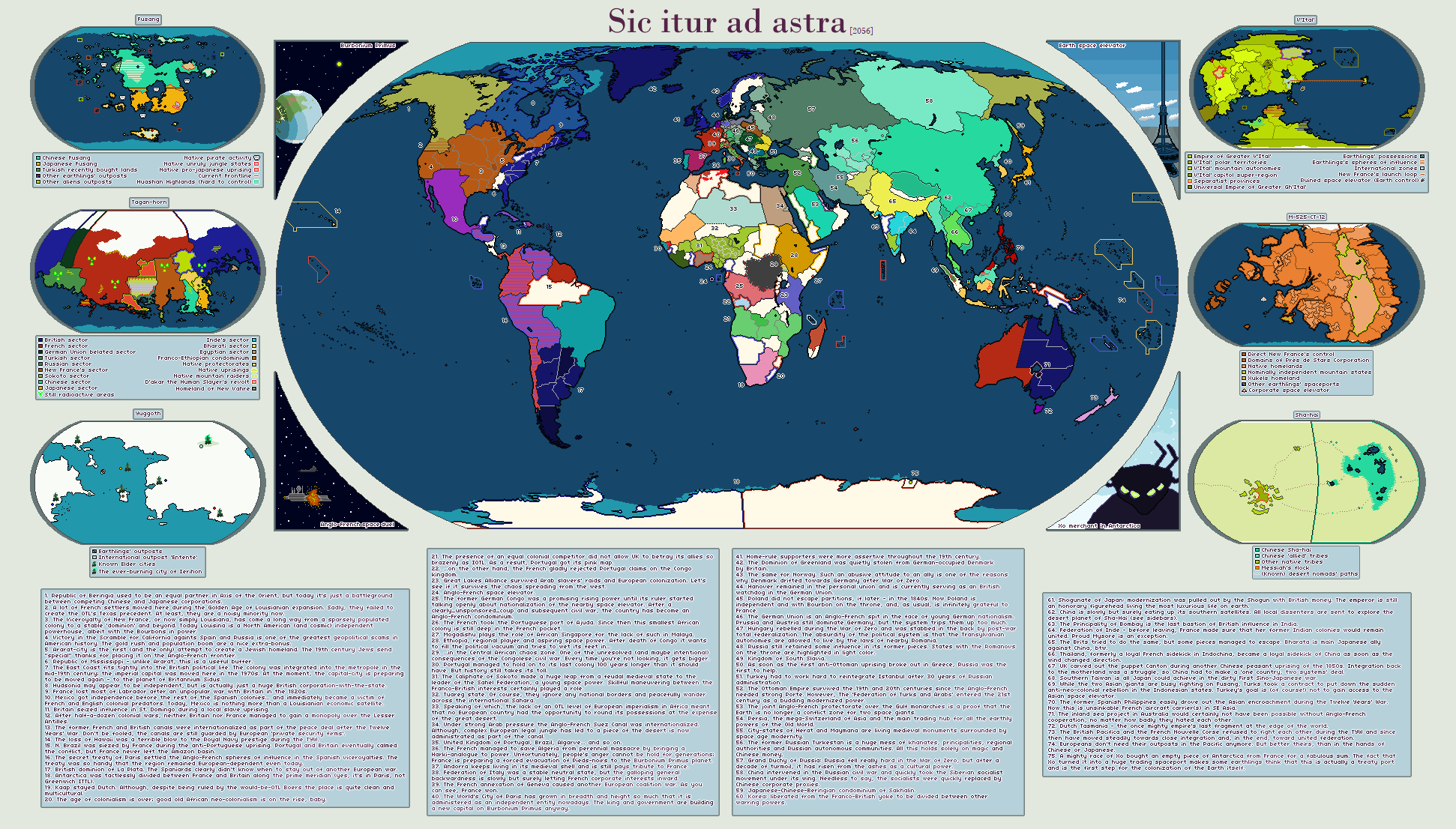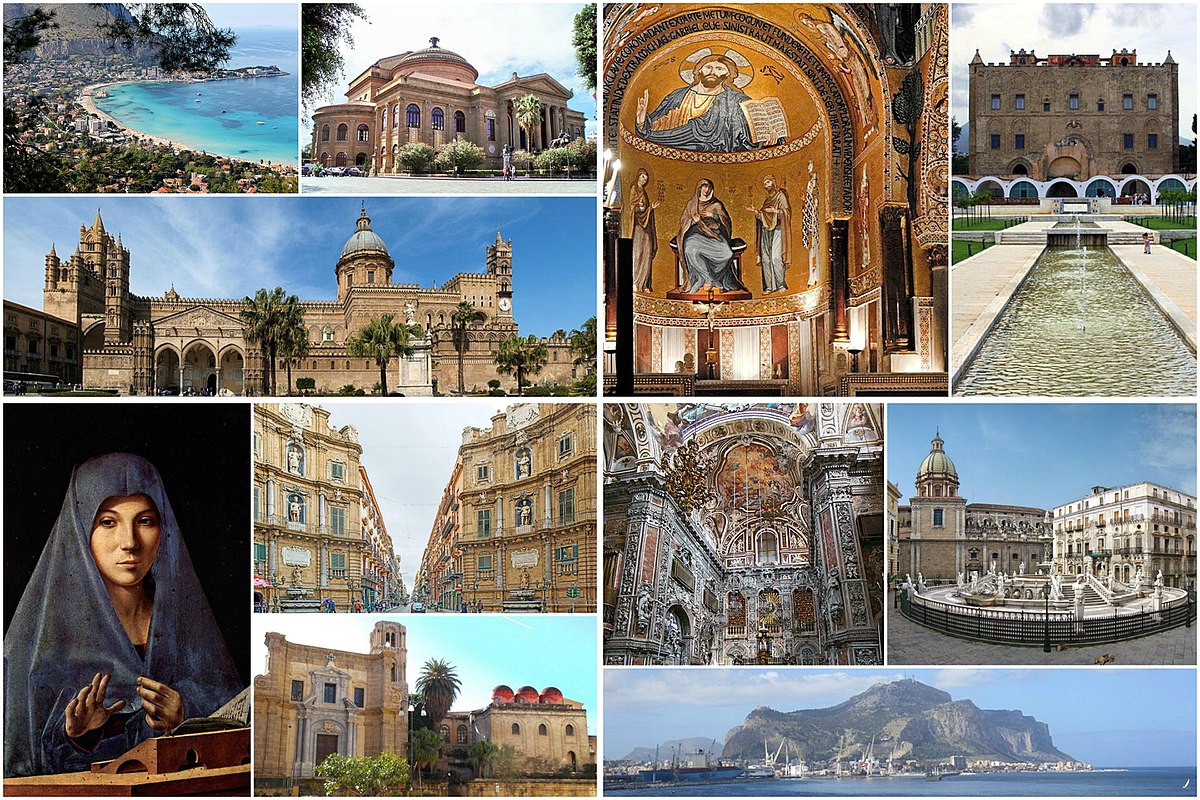

Sic itur ad Astra [2056] - cover
Disclaimer: this map is not intended to challenge existing territorial boundaries or revise past historical events. This is just a product of the author's fantasy created for entertainment. All characters and events are fictitious and any resemblance is purely coincidental.
My cover on the scenario of the magnificent @Mumby dA link, AH link
The Seven Years War was fought for longer and produced a result closer to the status quo than in OTL, with Britain taking the Ohio River, but only up to a point, and France maintained her ever present threat in North America. The Royal Navy never became the overwhelming force that it did in our world, but the tensions between the Great Powers were still not sufficiently resolved, and the British colonies in North America agreed to bear the onus of British militarisation for as long as the French threat was there. The 19th century was much like the 18th, a cycle of World Wars, primarily fought between Britain and France, with the other powers of Europe (Spain, Austria, Russia, Prussia, etc.) switching sides as they saw fit). Colonialism accelerated as both powers, and their turbulent allies looked for any advantage.
The eternal conflict between Paris and London saw the world become very different by the end of the 19th century. New France had become settled with Frenchmen and had expanded from a few forts on the Mississippi and some frozen villages in Canada to a continental behemoth which had annexed Spanish Tejas and California, and was bounded only by the territories of the Russian Pacific-North America Company, and the ever present Hudsons Bay Company. The British colonies had become industrialised and urban and had become the real heart of the British Empire. They and the Caribbean colonies had become part of the Kingdom proper some time ago. Much of Africa remained unexplored, but the coastal regions were thoroughly claimed and every colonial power had a catspaw which did their dirty work in the interior. Australia had become carved in two between Britain and France, and each extended a sphere of influence over the Viceroyalties of South America (Portugal and Spain tended to remain loyal to Britain and France respectively).
The wars didn't end in the 19th century. But they came to a brief halt when the German Travesty occurred. Since the 1700s, the rivalry between Prussia and Austria had been a dominant factor in the wars. That came tumbling down, and the world order was utterly altered when Prussia and Austria, in talks initiated and mediated by Russia, remade the Holy Roman Empire to suit their own desires. The Empire became an Imperial Republic, with an elected head of state and a separate elected head of government. Hapsburg and Hohenzollen territories, along with the rest of the HRE were merged into a single federal state. The HRE ceded some territory to Russia, and a new alliance was formed. Suddenly, the two party Anglo-French domination of the planet was challenged by a new Great Power. France and Britain reluctantly set aside their differences to confront the new foe. But in secret they sought out new allies, Britain building an alliance with the Shogunate of Japan, while France ingratiated themselves with the Qing Dynasty. They helped modernise these powers and almost excessively patronised them, hoping they could pick up the slack in Asia, while they devoted their efforts to the war in Europe.
The apocalyptic War of the Zero saw enormous advances in the fields of science and technology, specifically in combustion, aeronautics and chemicals. It also saw slaughter on an unprecedented scale. Millions died in the battlefields of Europe, Asia and the Americas, in frozen trenches and sweltering jungles in front of concrete fortresses or in a faeces-smeared punji trap. Britain and France emerged victorious, Russia sundered, the Imperial Holy Roman Republic broken apart and China and Japan had expanded at the expense of anti-'Entente' colonial powers. But revolution was breaking out in the non-settler colonies of the Entente, and with their dominance of the globe secured, the two once more began a dance of death.
For now, an uneasy peace reigned. The two superpowers were exhausted from the war, and their military power was tied down in Asia and Africa. They had to concede a lot of territory there before peace was finally secured and they had time concentrate on each other. By this point it was the 1930s, and a new threat was rising in the East. Japan and China didn't exactly see eye to eye but were well aware that they were treated as inferior by the Europeans. Along with the Republic of Beringia, the corpocratic descendant of the former Russian P-NA Company, they formed an Axis of the Orient, determined to cast the Anglo-French out of Eurasia.
The Twelve Years War in the 40s saw Britain and France exhaust themselves against one another, and the innovation of rocketry. It also saw the Anglo-French Empires in Asia collapse as the Eastern Axis took advantage of the distraction of Europe.
The Second Hundred Years War was becoming the Two Hundred Years War, and was also enterring one of its long truce periods as the Space Race began. Britain and France, now realising that unending war on Earth would lead only to ruin competed against one another in the fields of science and technology, with the Axis breaking apart and China and Japan competing against one another in a similar fashion.
As moon bases were built in the 60s and then onto Mars by the 70s, the raw materials from there replaced the output in Africa and the colonial corporations there moved their interests into space, along with hundreds of thousands of African colonists. As Europe left Africa, their catspaws took up the slack. China and Japan similarly utilised the populations of the East Indies and South Asia. It was the British invention of the gravity manipulating Cavor Drive which saw the birth of the Modern Era. The powers of Earth expanded outwards, and even the much weakened powers of Europe made their own efforts. A few of the wealthier African powers had a go.
Beyond our own Solar System, the starfaring empires of Humanity encountered many alien civilisations. Some were like mankind, young and expanding. Others were millennia old and decaying, decadent and rotten. Many more were primitive, savage even, and were scarcely recognised as worthy of the appelation 'civilised'. The Grand Opera of Britain and France's centuries long contest had reached a new crescendo.
The year is now 2056, and Earthly powers expand against the savages and contest for influence amongst the decaying. They war among themselves, and the two great superpowers, sit upon their throne-worlds of Britannium Sidus and Burbonium Primus as they fight for the title of leading empire of All Mankind and Sovereign Overlord of the Galaxy.
- Fusang
One of the first habitable planets discovered by Earthlings at the dawn of their space age of discovery. At that time, its native population - Kzors - were just primitive tribes with a couple of Bronze Age-like empires. Initially nicknamed 'Water World', the planet was not interesting to the Europeans... but it attracted China and Japan, who conquered the local tribes and states, and turned the population into indefinite 'wage workers'. And then it turned out that the mountains and oceans of Fusang are teeming with resources.
Today, the planet is divided into the Chinese and Japanese zones right along the equator. Numerous islets are inhabited by native refugees from the continent, fishermen, pirates, and sea nomads. Illegal Earthlings' and alien outposts pop up here and there; smuggling and space piracy flourish.
Recently, Japan and China entered a state of conflict over this planet (the equatorial border runs exactly along a new resource deposit). The so-called Fusang Jungle War has turned into a bloody trench meatgrinder, however, both sides are ready to fight to the bitter end - to the last Kzor.
Today, the planet is divided into the Chinese and Japanese zones right along the equator. Numerous islets are inhabited by native refugees from the continent, fishermen, pirates, and sea nomads. Illegal Earthlings' and alien outposts pop up here and there; smuggling and space piracy flourish.
Recently, Japan and China entered a state of conflict over this planet (the equatorial border runs exactly along a new resource deposit). The so-called Fusang Jungle War has turned into a bloody trench meatgrinder, however, both sides are ready to fight to the bitter end - to the last Kzor.
- Tagan-Horn
Example of how the Fermi Paradox and the bottleneck theory work. The Rogs civilization destroyed itself in a series of nuclear wars at the dawn of their space age. 500 years after, Earthlings discovered wild tribes of raiders living on the ruins of ancient cities. Initially, attempts were made to trade with the locals, but despite the vast resource wealth, the Rogs could offer only meager food, slaves, and scrap metal. An alternative solution was proposed at the Lunar conference of '47 when the Earthly powers unanimously decided to divide Tagan-Horn into spheres of influence and 'help' the Rogs return to the bosom of civilization... and to find a much better use of the planet's natural wealth.
Despite the obvious colonialism and banal oppression by Earthlings, the Rogs gained access to the lost benefits of civilization, such as medicine and food. Every year their number grows, as does dissatisfaction with the Earthly yoke. The Rogs now know that they are not wasteland savages, but former space explorers, and they intend to reclaim that title.
Despite the obvious colonialism and banal oppression by Earthlings, the Rogs gained access to the lost benefits of civilization, such as medicine and food. Every year their number grows, as does dissatisfaction with the Earthly yoke. The Rogs now know that they are not wasteland savages, but former space explorers, and they intend to reclaim that title.
- Yuggoth
Beneath miles of ice and snow, under the dim light of a dying white dwarf, lies the surface of the ancient planet Yuggoth - possibly the most curious planet found by humans. Judging by geomorphological analysis, it was the most remote outpost of a mighty vanished civilization, hundreds of times older than the oldest space empires. The cities dug out of the ice are a bewitching and eerie sight of the endless labyrinth of non-Euclidean geometry; the writing of this civilization drives any linguist crazy in a couple of days.
The locals - the wild degraded descendants of the planet's population - do not make any peaceful contact with the researchers. They are only concerned with surviving in this harsh area by any (and frightening) means available. Humans are either a delicacy for them or an excellent sacrifice for their creepy idols. An analysis of their activity and brains led to the conclusion that they are born with an extreme form of insanity.
Humanity, on its islands of civilization AKA outposts, is looking for useful resources or ancient technologies. In truth, there are rumors among the staff that it was obvious that there were no resources here from the beginning. Scientists are looking for something else. Something that persistently calls them in dreams and something that lurks somewhere under the eternal ice of this dying world. Something that waits.
The locals - the wild degraded descendants of the planet's population - do not make any peaceful contact with the researchers. They are only concerned with surviving in this harsh area by any (and frightening) means available. Humans are either a delicacy for them or an excellent sacrifice for their creepy idols. An analysis of their activity and brains led to the conclusion that they are born with an extreme form of insanity.
Humanity, on its islands of civilization AKA outposts, is looking for useful resources or ancient technologies. In truth, there are rumors among the staff that it was obvious that there were no resources here from the beginning. Scientists are looking for something else. Something that persistently calls them in dreams and something that lurks somewhere under the eternal ice of this dying world. Something that waits.
- V'Ital'
Once the capital of a sizable ancient space-based V'Ital'ian Empire controlled dozens of inhabited planets and hundreds of outposts. The greed of the local elites and their intrigues against each other weakened the homeworld; while the colonials grew in ambition and strength. After two space civil wars with a front exactly on V'ital', the capital planet has become the economic backyard of the Empire. While the greedy elites were carving up what was left of V'ital's former greatness, the colonies broke away and created their own space empires. And then Earthlings enter the scene.
Today, the once proud planet is in the tenacious clutches of young Earthly empires. They ruthlessly plunder the rich resources and technology of the V'Ital', while various local factions use their support to gain momentary advantage over each other.
Is this the end of an ancient empire? Well, one of its former fragments - the Gh'Ital'ian Empire - is now making a comeback to its homeland and slowly pushing the Earthlings off the planet. Do they really want to liberate the homeland of their ancestors or to take the humans' place - this is a big question.
Today, the once proud planet is in the tenacious clutches of young Earthly empires. They ruthlessly plunder the rich resources and technology of the V'Ital', while various local factions use their support to gain momentary advantage over each other.
Is this the end of an ancient empire? Well, one of its former fragments - the Gh'Ital'ian Empire - is now making a comeback to its homeland and slowly pushing the Earthlings off the planet. Do they really want to liberate the homeland of their ancestors or to take the humans' place - this is a big question.
- M-525-CT-12
The planet M-525-CT-12, or simply Andreyev-4, at the time of discovery, was in a state of endless two hundred years war between the native population and the warlike race of Xukels. The Xukels' home planet was destroyed by an asteroid, and the remnants of their fleet roamed endless space in search of a new home. They stumbled upon M-525-CT-12 at the height of its steam age. Desperate and wild from their long wanderings, the Xukels attacked the planet with all their cruelty and quickly conquered a huge chunk of it.
After looking at this mess and quickly thinking through their brains, the Earthlings came to the conclusion that it would be better to do business with more adequate and negotiable locals. With the help of the ambitious and cartoonish evil Louisianian corporation of Prés de Stars, the Earthlings helped to throw off the Xukels yoke... only to replace it with their own corporate yoke. The Earth was not opposed to such a turn, since profits flowed in much larger quantities than could be expected in the most daring forecasts.
Today, 30 years later, Prés de Stars is experiencing its first difficulties. 'The divide and rule' policy does not work for the young generation of locals, who are ready to discard religious and cultural differences in favor of their planetary identity. The flow of money and resources is running out, as the population refuses to work for food. New France is biting off piece by piece of the planet and is putting pressure on the corporation to hand over the planet to the government.
Thoughts are running through the minds of top managers: maybe a fully engineered uprising of the remaining Xukels and its subsequent suppression by the corporation will completely return the elusive control of the planet to their greedy hands?
After looking at this mess and quickly thinking through their brains, the Earthlings came to the conclusion that it would be better to do business with more adequate and negotiable locals. With the help of the ambitious and cartoonish evil Louisianian corporation of Prés de Stars, the Earthlings helped to throw off the Xukels yoke... only to replace it with their own corporate yoke. The Earth was not opposed to such a turn, since profits flowed in much larger quantities than could be expected in the most daring forecasts.
Today, 30 years later, Prés de Stars is experiencing its first difficulties. 'The divide and rule' policy does not work for the young generation of locals, who are ready to discard religious and cultural differences in favor of their planetary identity. The flow of money and resources is running out, as the population refuses to work for food. New France is biting off piece by piece of the planet and is putting pressure on the corporation to hand over the planet to the government.
Thoughts are running through the minds of top managers: maybe a fully engineered uprising of the remaining Xukels and its subsequent suppression by the corporation will completely return the elusive control of the planet to their greedy hands?
- Sha-hai
The planet of Sha-hai, or simply the Sand Sea, is a desert-scorched planet within a system of similar scorched desert planets. What distinguishes this planet from the rest is the atmosphere, water, and life. China quickly saw great potential in this world as the destination of incorrigible criminals, and then of entire disobedient peoples of Southeast Asia. The system of oases in the Sha-hai's eastern hemisphere turned into a huge penal colony. The local population was forced out of here either into the endless desert, where they joined the nomadic tribes or into the mountain system of the western hemisphere to settle in deep caves. The remaining locals became servants or a kind of foederati.
Other Terrestrial (and alien) empires have little interest in a ball of sand, so spaceships rarely visit Sha-hai. Accompanying rare visitors to the planet, rumors are returning to their native systems that the Chinese are mastering inaccessible terraforming technology, or that a messiah with extraordinary abilities has appeared among the desert nomads and started a holy war against China, or that the penal colony is just a cover to extract a new resource in the local sands. A resource that will change space travel forever.
Other Terrestrial (and alien) empires have little interest in a ball of sand, so spaceships rarely visit Sha-hai. Accompanying rare visitors to the planet, rumors are returning to their native systems that the Chinese are mastering inaccessible terraforming technology, or that a messiah with extraordinary abilities has appeared among the desert nomads and started a holy war against China, or that the penal colony is just a cover to extract a new resource in the local sands. A resource that will change space travel forever.
Credits:
- New France's subdivisions are inspired by this map
- Mississippi is from this map by Peter-MacPherson
- British La Plata is from here
- All rights to the idea of an alternate prime meridian belong to Mattystereo
- New Zealand belongs to iselander - map
- reference image for a space elevator
- Five alien planets done by donjon; fantasy map generator here
- While basemap for planet M-525-CT-12 is done by magnificent TrueBananakonda




